HC Verma Solutions: Chapter 2 - Physics & Mathematics | Physics Class 11 - NEET PDF Download
Page No. 27
Ques 1: Is a vector necessarily changed if it is rotated through an angle?
Ans: Yes. A vector is defined by its magnitude and direction, so a vector can be changed by changing its magnitude and direction. If we rotate it through an angle, its direction changes and we can say that the vector has changed.
Ques 2: Is it possible to add two vectors of unequal magnitudes and get zero? Is it possible to add three vectors of equal magnitudes and get zero?
Ans: No, it is not possible to obtain zero by adding two vectors of unequal magnitudes.
Example: Let us add two vectors  of unequal magnitudes acting in opposite directions. The resultant vector is given by
of unequal magnitudes acting in opposite directions. The resultant vector is given by
If two vectors are exactly opposite to each other, then 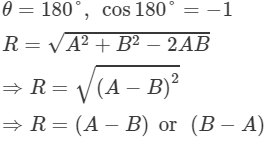
From the above equation, we can say that the resultant vector is zero (R = 0) when the magnitudes of the vectors  are equal (A = B) and both are acting in the opposite directions.
are equal (A = B) and both are acting in the opposite directions.
Yes, it is possible to add three vectors of equal magnitudes and get zero.
Lets take three vectors of equal magnitudes  given these three vectors make an angle of 120° with each other. Consider the figure below:
given these three vectors make an angle of 120° with each other. Consider the figure below: 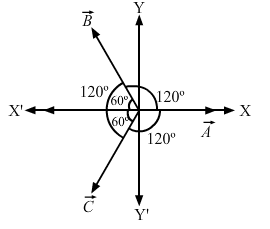
Lets examine the components of the three vectors.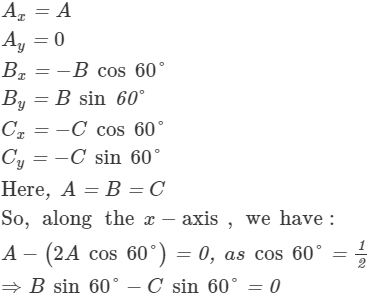
Hence, proved.
Ques 3: Does the phrase "direction of zero vector" have physical significance? Discuss it terms of velocity, force etc.
Ans: A zero vector has physical significance in physics, as the operations on the zero vector gives us a vector.
For any vector  , assume that
, assume that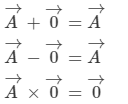
Again, for any real number λ we have: 
The significance of a zero vector can be better understood through the following examples:
The displacement vector of a stationary body for a time interval is a zero vector.
Similarly, the velocity vector of the stationary body is a zero vector.
When a ball, thrown upward from the ground, falls to the ground, the displacement vector is a zero vector, which defines the displacement of the ball.
Ques 4: Can you add three unit vectors to get a unit vector? Does your answer change if two unit vectors are along the coordinate axes?
Ans: Yes we can add three unit vectors to get a unit vector.
No, the answer does not change if two unit vectors are along the coordinate axes. Assume three unit vectors  along the positive x-axis, negative x-axis and positive y-axis, respectively. Consider the figure given below:
along the positive x-axis, negative x-axis and positive y-axis, respectively. Consider the figure given below: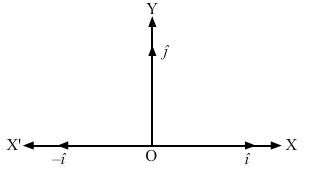
The magnitudes of the three unit vectors  are the same, but their directions are different.
are the same, but their directions are different.
So, the resultant of  is a zero vector.
is a zero vector.
Now, (Using the property of zero vector)
(Using the property of zero vector)
∴ The resultant of three unit vectors  is a unit vector
is a unit vector 
Page No. 28
Ques 5: Can we have physical quantities having magnitude and direction which are not vectors?
Ans: Yes, there are physical quantities like electric current and pressure which have magnitudes and directions, but are not considered as vectors because they do not follow vector laws of addition.
Ques 6: Which of the following two statements is more appropriate?
(a) Two forces are added using triangle rule because force is a vector quantity.
(b) Force is a vector quantity because two forces are added using triangle rule.
Ans: Two forces are added using triangle rule, because force is a vector quantity. This statement is more appropriate, because we know that force is a vector quantity and only vectors are added using triangle rule.
Ques 7: Can you add two vectors representing physical quantities having different dimensions? Can you multiply two vectors representing physical quantities having different dimensions?
Ans: No, we cannot add two vectors representing physical quantities of different dimensions. However, we can multiply two vectors representing physical quantities with different dimensions.
Example: Torque, 
Ques 8: Can a vector have zero component along a line and still have nonzero magnitude?
Ans: Yes, a vector can have zero components along a line and still have a nonzero magnitude.
Example: Consider a two dimensional vector This vector has zero components along a line lying along the Y-axis and a nonzero component along the X-axis. The magnitude of the vector is also nonzero.
This vector has zero components along a line lying along the Y-axis and a nonzero component along the X-axis. The magnitude of the vector is also nonzero.
Now, magnitude of 
Ques 9: Let ε1 and ε2 be the angles made by with the positive X-axis. Show that tan ε1 = tan ε2.Thus, giving tan ε does not uniquely determine the direction of
with the positive X-axis. Show that tan ε1 = tan ε2.Thus, giving tan ε does not uniquely determine the direction of 
Ans: The direction of is opposite to
is opposite to  So, if vector
So, if vector  make the angles ε1 and ε2 with the X-axis, respectively, then ε1 is equal to ε2 as shown in the figure:
make the angles ε1 and ε2 with the X-axis, respectively, then ε1 is equal to ε2 as shown in the figure: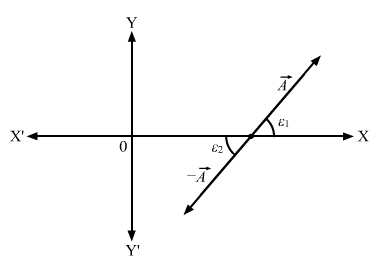
Here, tan ε1 = tan ε2
Because these are alternate angles.
Thus, giving tan ε does not uniquely determine the direction of 
Ques 10: Is the vector sum of the unit vectors  a unit vector? If no, can you multiply this sum by a scalar number to get a unit vector?
a unit vector? If no, can you multiply this sum by a scalar number to get a unit vector?
Ans: No, the vector sum of the unit vectors  is not a unit vector, because the magnitude of the resultant of
is not a unit vector, because the magnitude of the resultant of is not one.
is not one.
Magnitude of the resultant vector is given by
Yes, we can multiply this resultant vector by a scalar number  to get a unit vector.
to get a unit vector.
Ques 11: Let Write a vector
Write a vector  such that
such that  but A = B.
but A = B.
Ans: A vector  such that
such that  but A = B are as follows:
but A = B are as follows: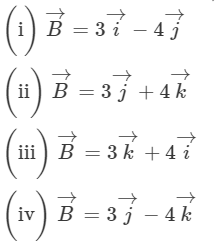
Ques 12: Can you have  with A ≠ 0 and B ≠ 0? What if one of the two vectors is zero?
with A ≠ 0 and B ≠ 0? What if one of the two vectors is zero?
Ans: No, we cannot have  with A ≠ 0 and B ≠ 0. This is because the left hand side of the given equation gives a vector quantity, while the right hand side gives a scalar quantity. However, if one of the two vectors is zero, then both the sides will be equal to zero and the relation will be valid.
with A ≠ 0 and B ≠ 0. This is because the left hand side of the given equation gives a vector quantity, while the right hand side gives a scalar quantity. However, if one of the two vectors is zero, then both the sides will be equal to zero and the relation will be valid.
Ques 13: If  can you say that (a)
can you say that (a) 
Ans: If  then both the vectors are either parallel or antiparallel, i.e., the angle between the vectors is either
then both the vectors are either parallel or antiparallel, i.e., the angle between the vectors is either 

Both the conditions can be satisfied:
(a)  i.e., the two vectors are equal in magnitude and parallel to each other
i.e., the two vectors are equal in magnitude and parallel to each other
(b)  i.e., the two vectors are unequal in magnitude and parallel or anti parallel to each other
i.e., the two vectors are unequal in magnitude and parallel or anti parallel to each other
Ques 14: Let  Do we have
Do we have  ? Can we say
? Can we say 
Ans: then we have
then we have  by putting the value of scalar k as −1.5-1.5.
by putting the value of scalar k as −1.5-1.5.
However, we cannot say that  because a vector cannot be divided by other vectors, as vector division is not possible.
because a vector cannot be divided by other vectors, as vector division is not possible.
Ques 15: A vector is not changed if
(a) it is rotated through an arbitrary angle
(b) it is multiplied by an arbitrary scalar
(c) it is cross multiplied by a unit vector
(d) it is slid parallel to itself.
Ans: (d) it is slid parallel to itself.
A vector is defined by its magnitude and direction. If we slide it to a parallel position to itself, then none of the given parameters, which define the vector, will change.
Let the magnitude of a displacement vector  directed towards the north be 5 metres. If we slide it parallel to itself, then the direction and magnitude will not change.
directed towards the north be 5 metres. If we slide it parallel to itself, then the direction and magnitude will not change.
Ques 16: Which of the sets given below may represent the magnitudes of three vectors adding to zero?
(a) 2, 4, 8
(b) 4, 8, 16
(c) 1, 2, 1
(d) 0.5, 1, 2
Ans: (c) 1, 2, 1
1,2 and 1 may represent the magnitudes of three vectors adding to zero.For example one of the vector of length 1 should make an angle of 135∘ with x axis and the other vector of length 1 makes an angle of 225∘ with x axis. The third vector of length 2 should lie along x axis.
Ques 17: The resultant of  makes an angle α with
makes an angle α with  and β with
and β with 
(a) α < β
(b) α < β if A < B
(c) α < β if A > B
(d) α < β if A = B
Ans:
(c) α < β if A > B
The resultant of two vectors is closer to the vector with the greater magnitude.
Thus, α < β if A > B
Ques 18: The component of a vector is
(a) always less than its magnitude
(b) always greater than its magnitude
(c) always equal to its magnitude
(d) None of these.
Ans: (d) None of these
All the given options are incorrect. The component of a vector may be less than, greater than or equal to its magnitude, depending upon the vector and its components.
Ques 19: A vector  points vertically upward and
points vertically upward and  points towards the north. The vector product
points towards the north. The vector product  is
is
(a) along the west
(b) along the east
(c) zero
(d) vertically downward.
Ans: (a) along the west
The vector product  will point towards the west. We can determine this direction using the right hand thumb rule.
will point towards the west. We can determine this direction using the right hand thumb rule.
Ques 20: The radius of a circle is stated as 2.12 cm. Its area should be written as
(a) 14 cm2
(b) 14.1 cm2
(c) 14.11 cm2
(d) 14.1124 cm2
Ans: (b) 14.1 cm2
Area of a circle, 
On putting the values, we get: 
The rules to determine the number of significant digits says that in the multiplication of two or more numbers, the number of significant digits in the answer should be equal to that of the number with the minimum number of significant digits. Here, 2.12 cm has a minimum of three significant digits. So, the answer must be written in three significant digits.
Ques 21: A situation may be described by using different sets coordinate axes having different orientation. Which the following do not depended on the orientation of the axis?
(a) the value of a scalar
(b) component of a vector
(c) a vector
(d) the magnitude of a vector.
Ans: (a) the value of a scalar
(c) a vector
(d) the magnitude of a vector
The value of a scalar, a vector and the magnitude of a vector do not depend on a given set of coordinate axes with different orientation. However, components of a vector depend on the orientation of the axes.
Ques 22: 
(a)  is always greater than
is always greater than 
(b) It is possible to have 
(c) C is always equal to A + B
(d) C is never equal to A + B.
Ans: (b) It is possible to have 
Statements (a), (c) and (d) are incorrect.
Given: 
Here, the magnitude of the resultant vector may or may not be equal to or less than the magnitudes of  or the sum of the magnitudes of both the vectors if the two vectors are in opposite directions.
or the sum of the magnitudes of both the vectors if the two vectors are in opposite directions.
Ques 23: Let the angle between two nonzero vectors  be 120° and its resultant be
be 120° and its resultant be 
(a) C must be equal to 
(b) C must be less than 
(c) C must be greater than 
(d) C may be equal to 
Ans: (b) C must be less than 
Here, we have three vector A, B and C.
Using the resultant property  we get:
we get: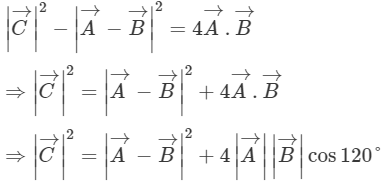
Since cosine is negative in the second quadrant, C must be less than 
Ques 24: The x-component of the resultant of several vectors
(a) is equal to the sum of the x-components of the vectors of the vectors
(b) may be smaller than the sum of the magnitudes of the vectors
(c) may be greater than the sum of the magnitudes of the vectors
(d) may be equal to the sum of the magnitudes of the vectors.
Ans: (a) is equal to the sum of the x-components of the vectors
(b) may be smaller than the sum of the magnitudes of the vectors
(d) may be equal to the sum of the magnitudes of the vectors.
The x-component of the resultant of several vectors cannot be greater than the sum of the magnitudes of the vectors.
Ques 25: The magnitude of the vector product of two vectors  may be
may be
(a) greater than AB
(b) equal to AB
(c) less than AB
(d) equal to zero.
Ans: (b) equal to AB
(c) less than AB
(d) equal to zero.
The magnitude of the vector product of two vectors  may be less than or equal to AB, or equal to zero, but cannot be greater than AB.
may be less than or equal to AB, or equal to zero, but cannot be greater than AB.
Page No. 29
Ques 26: A vector  makes an angle of 20° and
makes an angle of 20° and  makes an angle of 110° with the X-axis. The magnitudes of these vectors are 3 m and 4 m respectively. Find the resultant.
makes an angle of 110° with the X-axis. The magnitudes of these vectors are 3 m and 4 m respectively. Find the resultant.
Ans: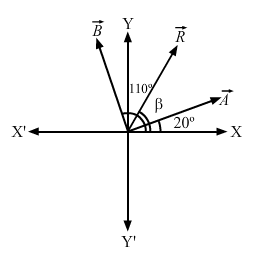
From the above figure, we have:
Angle between  = 110° − 20° = 90°
= 110° − 20° = 90°
Magnitude of the resultant vector is given by
Let β be the angle between 
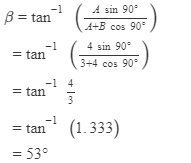
Ques 27: Let  be the two vectors of magnitude 10 unit each. If they are inclined to the X-axis at angle 30° and 60° respectively, find the resultant.
be the two vectors of magnitude 10 unit each. If they are inclined to the X-axis at angle 30° and 60° respectively, find the resultant.
Ans: Angle between  θ = 60° − 30° = 30°
θ = 60° − 30° = 30° =10 units
=10 units
The magnitude of the resultant vector is given by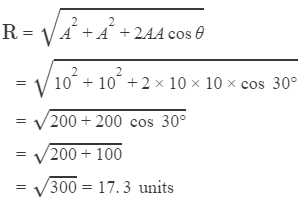
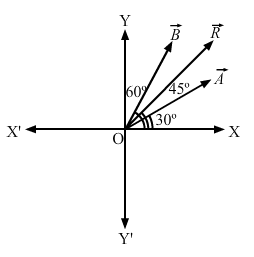
Let β be the angle between 
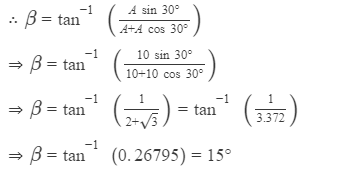
Angle made by the resultant vector with the X-axis = 15° + 30° = 45°
∴ The magnitude of the resultant vector is 17.3 and it makes angle of 45° with the X-axis.
Ques 28: Add vectors  each having magnitude of 100 unit and inclined to the X-axis at angles 45°, 135° and 315° respectively.
each having magnitude of 100 unit and inclined to the X-axis at angles 45°, 135° and 315° respectively.
Ans: First, we will find the components of the vector along the x-axis and y-axis. Then we will find the resultant x and y-components. 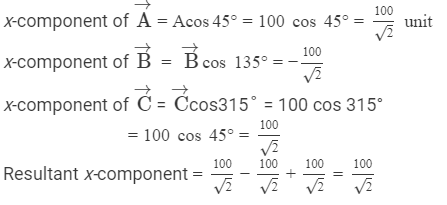
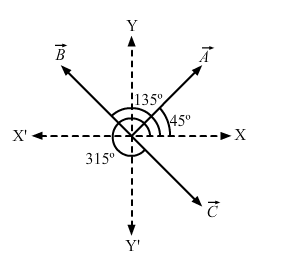
Now, y-component of 
y-component of 
y-component of 
Resultant y-component
Magnitude of the resultant 

Angle made by the resultant vector with the x-axis is given by 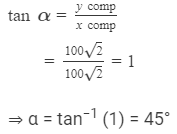
∴ The magnitude of the resultant vector is 100 units and it makes an angle of 45° with the x-axis.
Ques 28:  (a) Find the magnitudes of
(a) Find the magnitudes of  and (d)
and (d) 
Ans:
Given: 
(a) Magnitude of  is given by
is given by 
(b) Magnitude of  is given by
is given by 

∴ Magnitude of vector  is given by
is given by 

∴ Magnitude of vector  is given by
is given by 
Ques 29: Refer to figure (2-E1). Find (a) the magnitude, (b) x and y component and (c) the angle with the X-axis of the resultant of 
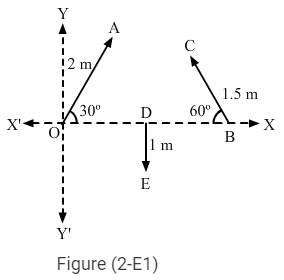
Ans: First, let us find the components of the vectors along the x and y-axes. Then we will find the resultant x and y-components.
x-component of 
x-component of 
x-component of 
y-component of 
y-component of 
y-component of 
x-component of resultant Rx=
y-component of resultant Ry = 
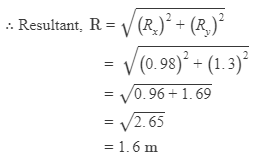
If it makes an angle α with the positive x-axis, then
Ques 30: Two vectors have magnitudes 2 unit and 4 unit respectively. What should be the angle between them if the magnitude of the resultant is (a) 1 unit, (b) 5 unit and (c) 7 unit.
Ans: Let the two vectors be 

(a) If the resultant vector is 1 unit, then
Squaring both sides, we get:
Hence, the angle between them is 180°.
(b) If the resultant vector is 5 units, then
Squaring both sides, we get:
Hence, the angle between them is 90°.
(c) If the resultant vector is 7 units, then
Squaring both sides, we get: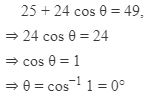
Hence, the angle between them is 0°.
Ques 31: A spy report about a suspected car reads as follows. "The car moved 2.00 km towards east, made a perpendicular left turn, ran for 500 m, made a perpendicular right turn, ran for 4.00 km and stopped". Find the displacement of the car.
Ans: The displacement of the car is represented by 

Magnitude of  is given by
is given by 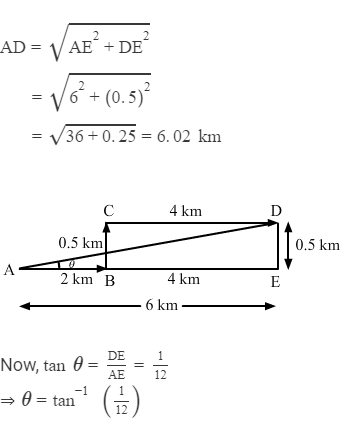
Hence, the displacement of the car is 6.02 km along the direction  with positive the x-axis.
with positive the x-axis.
Ques 32: A carrom board (4 ft × 4 ft square) has the queen at the centre. The queen, hit by the striker moves to the from edge, rebounds and goes in the hole behind the striking line. Find the magnitude of displacement of the queen (a) from the centre to the front edge, (b) from the front edge to the hole and (c) from the centre to the hole.
Ans: 
Consider that the queen is initially at point A as shown in the figure.
Let AB be x ft.
So, DE = (2 −- x) ft
In ∆ABC, we have: 
Also, in ∆DCE, we have: 
From (i) and (ii), we get: 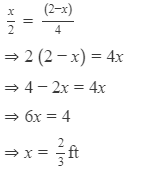
(a) In ∆ABC, we have: 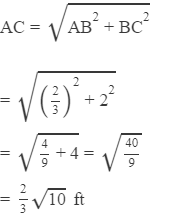
(b) In ∆CDE, we have:
CD = 4 ft 
(c) In ∆AGE, we have: 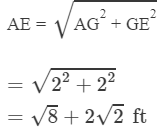
Ques 33: A mosquito net over a 7 ft × 4 ft bed is 3 ft high. The net has a hole at one corner of the bed through which a mosquito enters the net. It flies and sits at the diagonally opposite upper corner of the net. (a) Find the magnitude of the displacement of the mosquito. (b) Taking the hole as the origin, the length of the bed as the X-axis, it width as the Y-axis, and vertically up as the Z-axis, write the components of the displacement vector.
Ans: Displacement vector of the mosquito, 
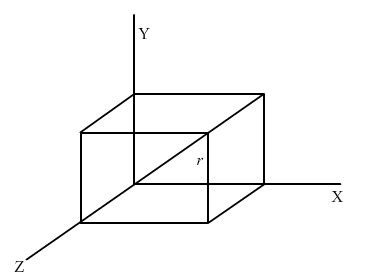
(a) Magnitude of displacement= 

(b) The components of the displacement vector are 7 ft, 4 ft and 3 ft along the X, Y and Z-axes, respectively.
Ques 34: Suppose  is a vector of magnitude 4.5 units due north. What is the vector (a)
is a vector of magnitude 4.5 units due north. What is the vector (a) 
Ans: Given:  is a vector of magnitude 4.5 units due north.
is a vector of magnitude 4.5 units due north.
Case (a):
 is a vector of magnitude 13.5 units due north.
is a vector of magnitude 13.5 units due north.
Case (b):
 is a vector of magnitude 6 units due south.
is a vector of magnitude 6 units due south.
Ques 35: Two vectors have magnitudes 2 m and 3m. The angle between them is 60°. Find (a) the scalar product of the two vectors, (b) the magnitude of their vector product.
Ans: Let the two vectors be 
Angle between the vectors, θ = 60°
(a) The scalar product of two vectors is given by 

(b) The vector product of two vectors is given by 
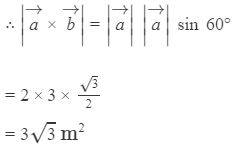
Ques 36: Let A1 A2 A3 A4 A5 A6 A1 be a regular hexagon. Write the x-components of the vectors represented by the six sides taken in order. Use the fact the resultant of these six vectors is zero, to prove that cos 0 + cos π/3 + cos 2π/3 + cos 3π/3 + cos 4π/3 + cos 5π/3 = 0. Use the known cosine values to verify the result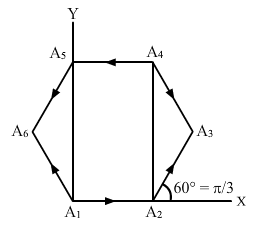
Ans: According to the polygon law of vector addition, the resultant of these six vectors is zero.Here, a = b = c = d = e = f (magnitudes), as it is a regular hexagon. A regular polygon has all sides equal to each other.
So, 
[As the resultant is zero, the x-component of resultant Rx is zero]
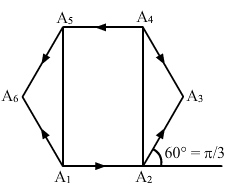
Note: Similarly, it can be proven that 
Ques 37: Let  Find the angle between them.
Find the angle between them.
Ans: We have:
Using scalar product, we can find the angle between vectors 
i.e., 
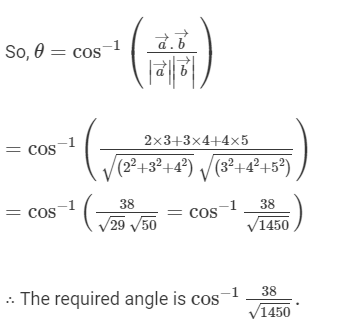
Ques 38: Prove that 
Ans: To prove:
Proof: Vector product is given by 
 is a vector which is perpendicular to the plane containing
is a vector which is perpendicular to the plane containing 
This implies that it is also perpendicular to  We know that the dot product of two perpendicular vectors is zero.
We know that the dot product of two perpendicular vectors is zero. 
Hence, proved.
Ques 39: 
Ans: Given: 

The vector product of  can be obtained as follows:
can be obtained as follows: 
Ques 40: If  are mutually perpendicular, show that
are mutually perpendicular, show that  Is the converse true?
Is the converse true?
Ans: Given:  are mutually perpendicular.
are mutually perpendicular.  is a vector with its direction perpendicular to the plane containing
is a vector with its direction perpendicular to the plane containing 
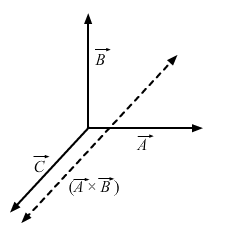
∴ The angle between  is either 0° or 180°.
is either 0° or 180°.
i.e., 
However, the converse is not true. For example, if two of the vectors are parallel, then also, 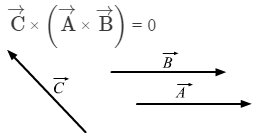
So, they need not be mutually perpendicular.
Ques 41: A particle moves on a given straight line with a constant speed ν. At a certain time it is at a point P on its straight line path. O is a fixed point. Show that  is independent of the position P.
is independent of the position P.
Ans: The particle moves on the straight line XX' at a uniform speed ν.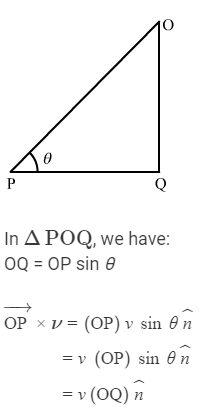
This product is always equal to the perpendicular distance from point O. Also, the direction of this product remains constant.
So, irrespective of the the position of the particle, the magnitude and direction of  remain constant.
remain constant.  is independent of the position P.
is independent of the position P.
Ques 42: The force on a charged particle due to electric and magnetic fields is given by  Suppose
Suppose  is along the X-axis and
is along the X-axis and  along the Y-axis. In what direction and with what minimum speed ν should a positively charged particle be sent so that the net force on it is zero?
along the Y-axis. In what direction and with what minimum speed ν should a positively charged particle be sent so that the net force on it is zero?
Ans: According to the problem, the net electric and magnetic forces on the particle should be zero. 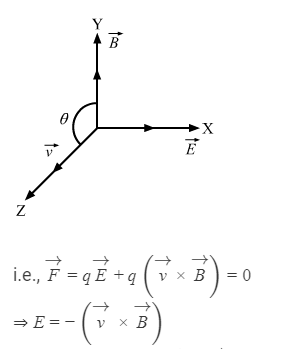
So, the direction of  should be opposite to the direction of
should be opposite to the direction of  Hence,
Hence,  should be along the positive z-direction.
should be along the positive z-direction.
Again, 

For ν to be minimum, θ=90° and, thus 
So, the particle must be projected at a minimum speed of  along the z-axis.
along the z-axis.
Ques 43: Give an example for which 
Ans:
To prove: 
Suppose that  is perpendicular to
is perpendicular to  is along the west direction.
is along the west direction.
Also,  is perpendicular to
is perpendicular to  are along the south and north directions, respectively.
are along the south and north directions, respectively. 
 is perpendicular to
is perpendicular to  so there dot or scalar product is zero.
so there dot or scalar product is zero.
i.e.,

 is perpendicular to
is perpendicular to so there dot or scalar product is zero.
so there dot or scalar product is zero.
i.e., 

Hence, proved.
Ques 44: Draw a graph from the following data. Draw tangents at x = 2, 6 and 8. Find the slopes of these tangents. Verify that the curve draw is y = 2x2 and the slope of tangent is 

Ans:
Note: Students should draw the graph y = 2x2 on a graph paper for results.
To find a slope at any point, draw a tangent at the point and extend the line to meet the x-axis. Then find tan θ as shown in the figure.
The above can be checked as follows:
Slope 

Here, x = x-coordinate of the point where the slope is to be measured
Ques 45: A curve is represented by y = sin x. If x is changed from  find approximately the change in y.
find approximately the change in y.
Ans: y = sin x ...(i)
Now, consider a small increment ∆x in x.
Then y + ∆y = sin (x + ∆x) ...(ii)
Here, ∆y is the small change in y.
Subtracting (ii) from (i), we get:
∆y = sin (x + ∆x) − sin x 
= 0.0157
Ques 46: The electric current in a charging R−C circuit is given by  R and C are constant parameters of the circuit and t is time. Find the rate of change of current at (a) t = 0, (b) t = RC, (c) t= 10 RC.
R and C are constant parameters of the circuit and t is time. Find the rate of change of current at (a) t = 0, (b) t = RC, (c) t= 10 RC.
Ans: Given:
∴ Rate of change of current 

On applying the conditions given in the questions, we get: 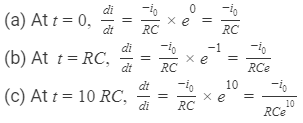
Ques 47: The electric current in a discharging R−C circuit is given by  R and C are constant parameters and t is time. Let
R and C are constant parameters and t is time. Let
 (a) Find the current at t = 0⋅3 s. (b) Find the rate of change of current at at 0⋅3 s. (c) Find approximately the current at t = 0⋅31 s.
(a) Find the current at t = 0⋅3 s. (b) Find the rate of change of current at at 0⋅3 s. (c) Find approximately the current at t = 0⋅31 s.
Ans: Electric current in a discharging R-C circuit is given by the below equation:
i = i0 ⋅ e−t/RC ...(i)
Here, i0 = 2.00 A
R = 6 × 105 Ω
C = 0.0500 × 10−6 F
= 5 × 10−7 F
On substituting the values of R, C and i0 in equation (i), we get:
i = 2.0 e−t/0.3 ...(ii)
According to the question, we have:
(a) current at t = 0.3 s 
(b) rate of change of current at t = 0.3 s 
When t = 0.3 s, we have: 
(c) approximate current at t = 0.31 s 
Page No.30
Ques 48: Find the area bounded under the curve y = 3x2 + 6x + 7 and the X-axis with the ordinates at x = 5 and x = 10.
Ans: The given equation of the curve is y = 3x2 + 6x + 7.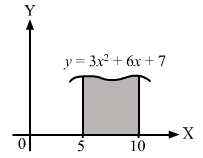
The area bounded by the curve and the X-axis with coordinates x1 = 5 and x2 = 10 is given by 
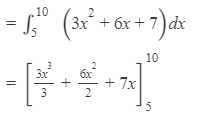

Ques 49: Find the area enclosed by the curve y = sin x and the X-axis between x = 0 and x = π.
Ans: The given equation of the curve is y = sin x. 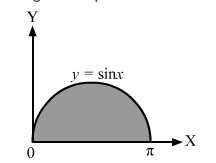
The required area can found by integrating y w.r.t x within the proper limits. 
=1+1=2 sq. unit
Ques 50: Find the area bounded by the curve y = e−x, the X-axis and the Y-axis.
Ans: The given function is y = e−x.
When x = 0, y = e−0 = 1
When x increases, the value of y decrease. Also, only when x = ∞, y = 0
So, the required area can be determined by integrating the function from 0 to ∞. 
=−[0−1]=1 sq. unit
Ques 51: A rod of length L is placed along the X-axis between x = 0 and x = L. The linear density (mass/length) ρ of the rod varies with the distance x from the origin as ρ = a + bx. (a) Find the SI units of a and b. (b) Find the mass of the rod in terms of a, b and L.
Ans: ρ = mass/length = a + bx
So, the SI unit of ρ is kg/m.
(a)
SI unit of a = kg/m
SI unit of b = kg/m2
(From the principle of homogeneity of dimensions)
(b) Let us consider a small element of length dx at a distance x from the origin as shown in the figure given below: 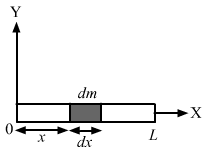
dm = mass of the element
= ρdx
= (a + dx) dx
∴ Mass of the rod = ∫ dm 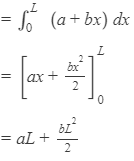
Ques 52: The momentum p of a particle changes with time t according to the relation 
Ans: According to the question, we have: 
Momentum is zero at time, t = 0
Now, dp = [(10 N) + (2 Ns−1)t]dt
On integrating the above equation, we get: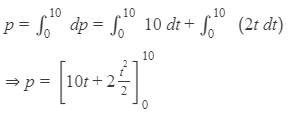

Ques 53: The changes in a function y and the independent variable x are related as  Find y as a function of x.
Find y as a function of x.
Ans: Changes in a function of y and the independent variable x are related as follows: 
Integrating of both sides, we get:
∫dy = ∫x2 dx  where c is a constant
where c is a constant
∴ y as a function of x is represented by 
Ques 54: Write the number of significant digits in (a) 1001, (b) 100.1, (c) 100.10, (d) 0.001001.
Ans: (a) 1001
Number of significant digits = 4
(b) 100.1
Number of significant digits = 4
(c) 100.10
Number of significant digits = 5
(d) 0.001001
Number of significant digits = 4
Ques 55: A metre scale is graduated at every millimetre. How many significant digits will be there in a length measurement with this scale?
Ans: The metre scale is graduated at every millimetre.
i.e., 1 m = 1000 mm
The minimum number of significant digits may be one (e.g., for measurements like 4 mm and 6 mm) and the maximum number of significant digits may be 4 (e.g., for measurements like 1000 mm). Hence, the number of significant digits may be 1, 2, 3 or 4.
Ques 56: Round the following numbers to 2 significant digits.
(a) 3472, (b) 84.16. (c)2.55 and (d) 28.5
Ans: (a) In 3472, 7 comes after the digit 4. Its value is greater than 5. So, the next two digits are neglected and 4 is increased by one.
∴ The value becomes 3500.
(b) 84
(c) 2.6
(d) 29
Ques 57: The length and the radius of a cylinder measured with a slide callipers are found to be 4.54 cm and 1.75 cm respectively. Calculate the volume of the cylinder.
Ans: Length of the cylinder, l = 4.54 cm
Radius of the cylinder, r = 1.75 cm
Volume of the cylinder, V = π2l
= (π) × (4.54) × (1.75)2 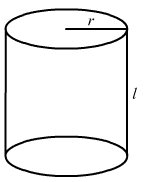
The minimum number of significant digits in a particular term is three. Therefore, the result should have three significant digits, while the other digits should be rounded off.
∴ Volume, V = πr2l
= (3.14) × (1.75) × (1.75) × (4.54)
= 43.6577 cm3
Since the volume is to be rounded off to 3 significant digits, we have:
V = 43.7 cm3
Ques 58: The thickness of a glass plate is measured to be 2.17 mm, 2.17 mm and 2.18 mm at three different places. Find the average thickness of the plate from this data.
Ans: Average thickness
=2.1733 mm
∴ Rounding off to three significant digits, the average thickness becomes 2.17 mm.
Ques 59: The length of the string of a simple pendulum is measured with a metre scale to be 90.0 cm. The radius of the bod plus the length of the hook is calculated to be 2.13 cm using measurements with a slide callipers. What is the effective length of the pendulum? (The effective length is defined as the distance between the point of suspension and the centre of the bob.)
Ans: Consider the figure shown below: 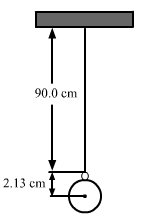
Actual effective length = (90.0 + 2.13) cm
However, in the measurement 90.0 cm, the number of significant digits is only two.
So, the effective length should contain only two significant digits.
i.e., effective length = 90.0 + 2.13 = 92.1 cm.
|
96 videos|367 docs|98 tests
|
FAQs on HC Verma Solutions: Chapter 2 - Physics & Mathematics - Physics Class 11 - NEET
| 1. What are HC Verma Solutions? |  |
| 2. Are HC Verma Solutions for Chapter 2 useful for both physics and mathematics? |  |
| 3. How can HC Verma Solutions for Chapter 2 help in exam preparation? |  |
| 4. Can HC Verma Solutions for Chapter 2 be used by students of all levels? |  |
| 5. Where can I find HC Verma Solutions for Chapter 2? |  |






















